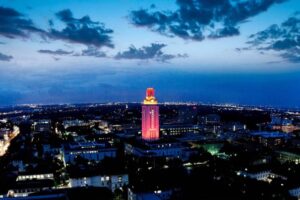AUSTIN, Texas —Officials with the McDonald Observatory, the Big Bend Astronomical Society, American Electric Power (AEP) and the city of Alpine have completed work on a city ordinance aimed at preserving the darkness and clarity of the night sky while providing cheaper, more efficient outdoor lighting.
Astronomers said the effort could be a model for other cities throughout Texas seeking to cut costs on electric bills and to reduce light pollution.
McDonald Observatory, a research facility of The University of Texas at Austin, is famous among astronomers for being the darkest astronomical observation site located within the continental United States, and its astronomers want to keep it that way.
Light pollution is a growing problem in urban nations, as the size of cities and the intensity of outdoor lighting increases. Dr. Frank Bash, McDonald Observatory director, explained that the night is “getting brighter and brighter because of all the light that is getting spilled into the sky and that makes astronomy very difficult to do. People just don’t see the stars, and it’s really sad.
“By working cooperatively with cities like Alpine, we can show that you can save money by directing light onto the ground — where you want it — and keep the sky dark at night,” Bash said. “Other cities could use the Alpine ordinance as a model.”
Approved unanimously by the Alpine City Council, the measure went on the books in June. It allows existing lighting to remain in place, but requires full cut-off lighting for new public or private installations, which means no direct light escapes above a horizontal plane at the bottom of the fixture.
“Light that goes up into the sky but doesn’t go into the parking lot or the area you are trying to light is wasted,” Bash said. “You can use a much smaller bulb — with appropriate shields and reflectors that reflect light down on the ground — and you can save yourself a lot of money.”
Also collaborating on the ordinance were McDonald Observatory Superintendent Dr. Mark T. Adams; McDonald’s expert on light pollution, Bill Wren; Roland Pena, manager of Community Services for AEP-West Texas Utilities in the Big Bend and Western Regions; and James Walker of the Big Bend Astronomical Society.
Wren explained that because full cut-off lighting redirects light downwards, the same amount of illumination can be achieved using a lower wattage bulb. “For example, you can switch from a 175-watt mercury vapor light to a 100-watt high pressure sodium light in combination with a glare shield and get the same amount of illumination for about half the electricity cost,” Wren said.
Cities aren’t the only beneficiaries. One South Texas refinery is expecting to save $1 million per year after retrofitting 20,000 light fixtures, Wren said.
“The good news is that most manufacturers are currently making fixtures that were designed to be cost-efficient to start with, designed with the glare shielding already built in,” Wren said. Wren said if legislation and ordinances are put in place “that prevent the spread of any more bad lighting, then it becomes a shrinking problem. As older fixtures burn out, they can be replaced.”
Wren noted that Tucson, Ariz., adopted a lighting ordinance 20 years ago, “and you can see the Milky Way from within the city limits.”
James Walker of the Big Bend Astronomical Society said: “Our new lighting ordinance will reduce light pollution, keep the sky darker so we can see the stars better and conserve energy. I believe we have a good ordinance that is enforceable and is fair to everyone.”
For more information, contact: Bill Wren at (915) 426-3640 or e-mail: wren@astro.as.utexas.edu. For more information on full cutoff lighting, see www.darksky.org.



